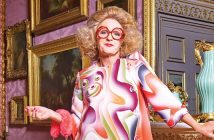I normally give myself two hours to see an exhibition. Not because this constitutes any kind of magic number. Alfred Hitchcock once remarked that a film’s duration should not exceed the capacity of a human bladder, which he gave at about two hours. I have simply transferred this figure to the realms of exhibition going, and it seems to have served me well. If an exhibition contains more than can be experienced in this period, I spend the time with those works that most speak to me and then head for the exit. If it contains less, then I feel short-changed. But generally speaking, most exhibitions are adequately despatched in two hours. In David Hockney RA: 82 Portraits and 1 Still Life at the Royal Academy of Arts, I was done in just over twenty minutes. Had I missed something?

Lord Jacob Rothschild
I paced around the four rooms making up the exhibition space in the Sackler Wing. No, I had seen it all. I gave it another thirty minutes but once more the paintings defied penetration. I have found that good paintings engage and that with great paintings, I can “go into them” – they offer up mysteries, communion. These did neither. They were flat, lifeless. Hockney states in a recent interview with RA curator Edith Devaney, apropos this collection, that, “We are all different, and I think that’s a joy.” Unfortunately, my overriding impression here was that all the portraits looked the same. Admittedly, part of this was deliberate. They are all painted on canvases of the same size (121.9 x 91.4 cm), with sitters using the same chair. The backgrounds are all shades of cerulean blue, cyan and turquoise – colours that will be familiar to those who know the painter’s work from his sixties-era Los Angeles period. This is no accident. Hockney is again resident in the City of Angels, returned from a sojourn in the county of his birth, and once again he has picked up the acrylics.
No. It isn’t that these paintings look the same, it is that they feel the same. And that, to my mind, is fatal. In Honoré de Balzac’s tale, The Unknown Masterpiece, old Frenhofer remarks, “It’s not the mission of art to copy nature, but to express it!” Again, these portraits do neither. Rather, they express the personality of the painter in a watery and unprofound way. That isn’t to say that there isn’t ambition here – ninety portraits in two years. Hockney set himself the task of completing each painting in a dizzying three days. Unfortunately most of them look it. The brush strokes are ugly, the colours gaudy rather than vibrant. I paraphrase Frenhofer when I say that the sitters do not breath, they do not live. That is not to say that a good painting cannot be completed quickly, but it should take as long as it needs to take, whether that is ten minutes or ten months. It cannot be confined to three days ninety times like casting a mould for a shoe. That is not art. That is mass production. Again, that is not to say that this experiment (and it is an experiment) may not have worked, but that it does not.

Celia Birtwell
Most of the sitters will not be instantly recognisable to an English public – Barry Humphries was the only one I knew at a glance – for they constitute a combination of the great and the good; an elderly scion of the House of Rothschild turns up, along with assorted dealers and other artists, Bing McGilvray and John Baldessari included, as well as old acquaintances and family members. Hockney’s sister Margaret is present as is a brother and his longtime companion Gregory Evans. There are also two portraits of he artist’s studio manager, Parisian born Jean-Pierre Goncalves de Lima, who prepared and managed each one of these sessions. Perhaps the most interesting painting of the lot is the first of these where de Lima sits, elbows on knees, head in hands, his face concealed. Is the sitter grieving for something or perhaps just plunged in the boredom of sitting? It is a portrait which contains the hints of mystery missing elsewhere. For Hockney aficionados there is also a portrait of Celia Birtwell, the textile designer who has been a friend of the painter’s for five decades and who was the subject in the celebrated double portrait Mr and Mrs Clark and Percy from 1970-71.
None of these portraits is a commission. Each of the sitters was invited to take part and Hockney is keen that the collection be looked upon as a whole. The one anomaly – the still life – was painted in lieu of a subject who failed to turn up, Hockney utilising what fruit and vegetables were available to him at the studio. The most interesting thing for me was that the sitters chose both their pose and their clothes for the sitting. Why that shirt? Why that tie? Why a tie at all? And why sit in that extraordinary way? These are questions of curiosity never to be posed to the sitters themselves but perhaps have little to do with the outcome of the paintings.

In Somerset Maugham’s Of Human Bondage, the hero Philip Carey pores over reproductions of El Greco’s masterpieces, longing to travel to Spain to see the originals. I felt quite the opposite here. The reproductions of Hockney’s portraits in the gallery guide were striking, intriguing, but when confronted with the originals I felt sorely disappointed. Hockney sprang out of the Pop Art movement of the sixties and this is where these paintings might work – as graphic art, posters. But as paintings and portraiture? No.
David Hockney RA: 82 Portraits and 1 Still Life at the Royal Academy of Arts, Burlington House, Piccadilly, London, until 2nd October 2016. Tickets £11.50 (without donation £10). For more information and tickets visit the website.




